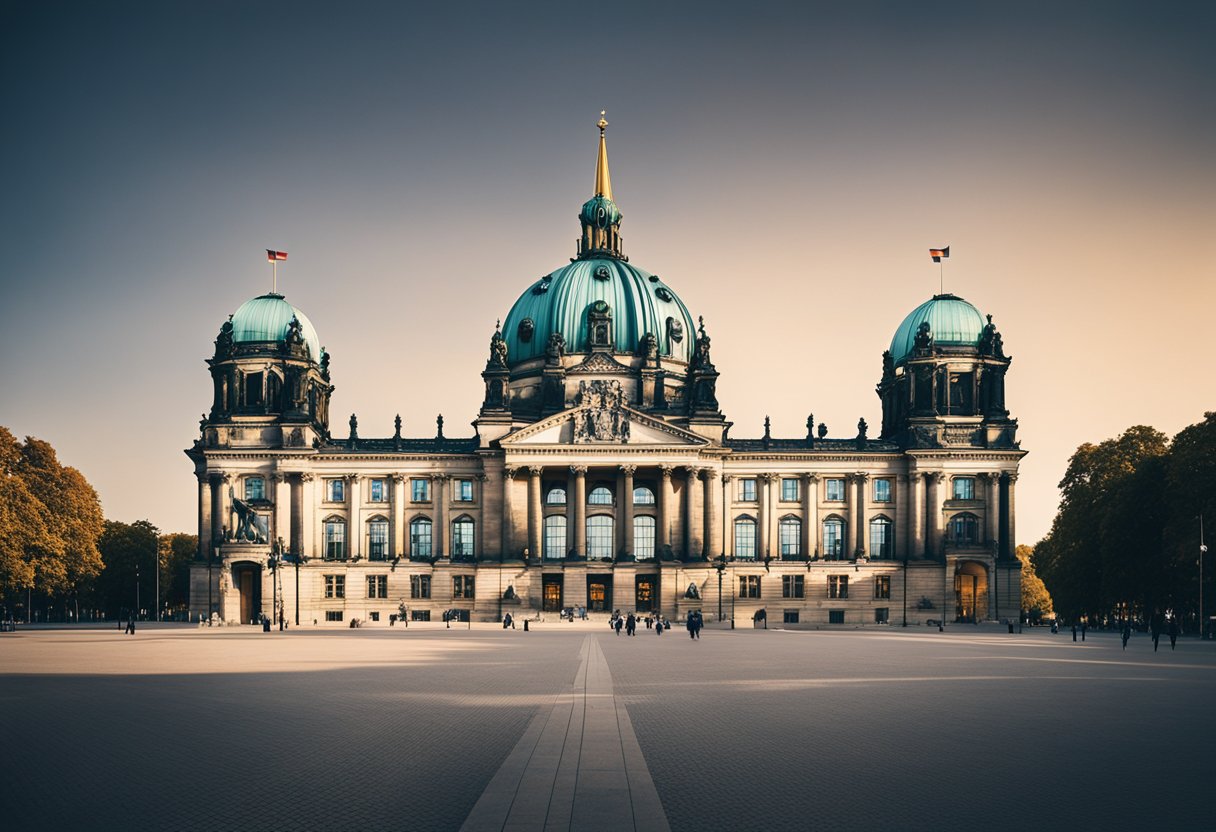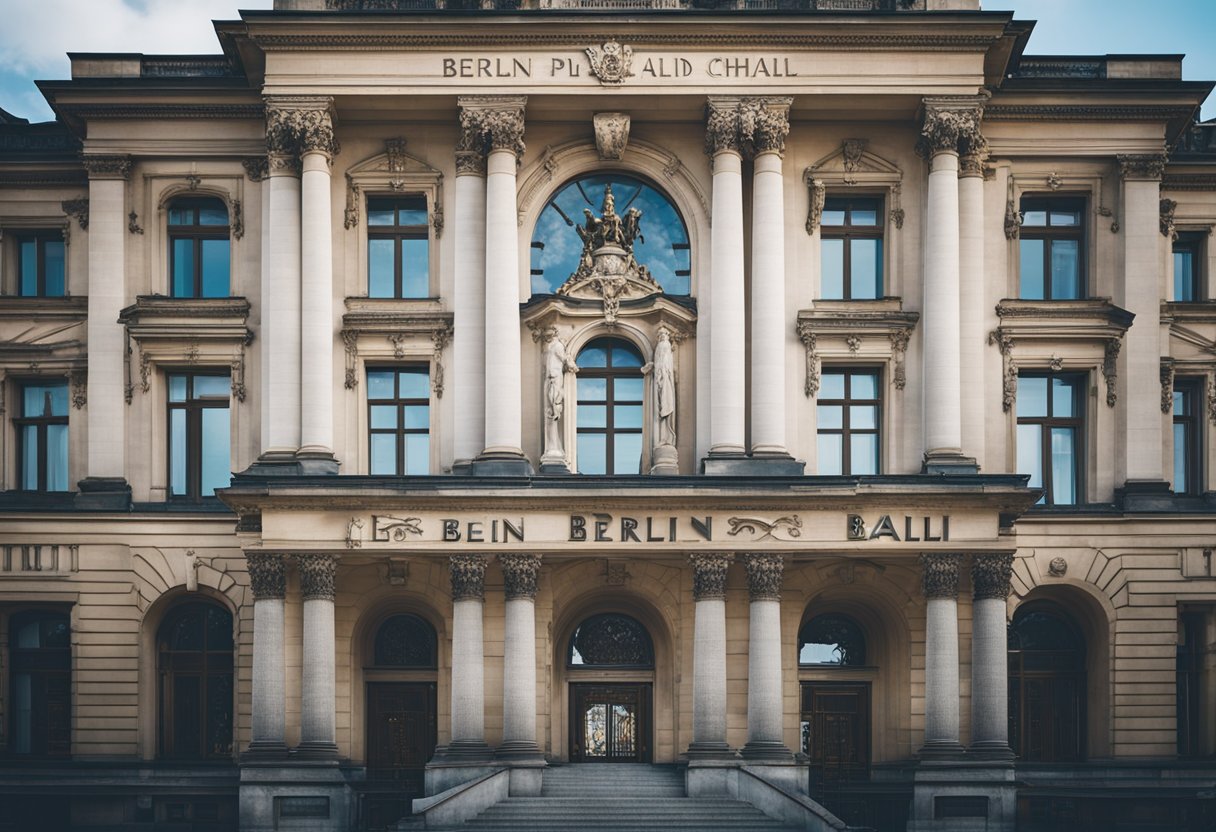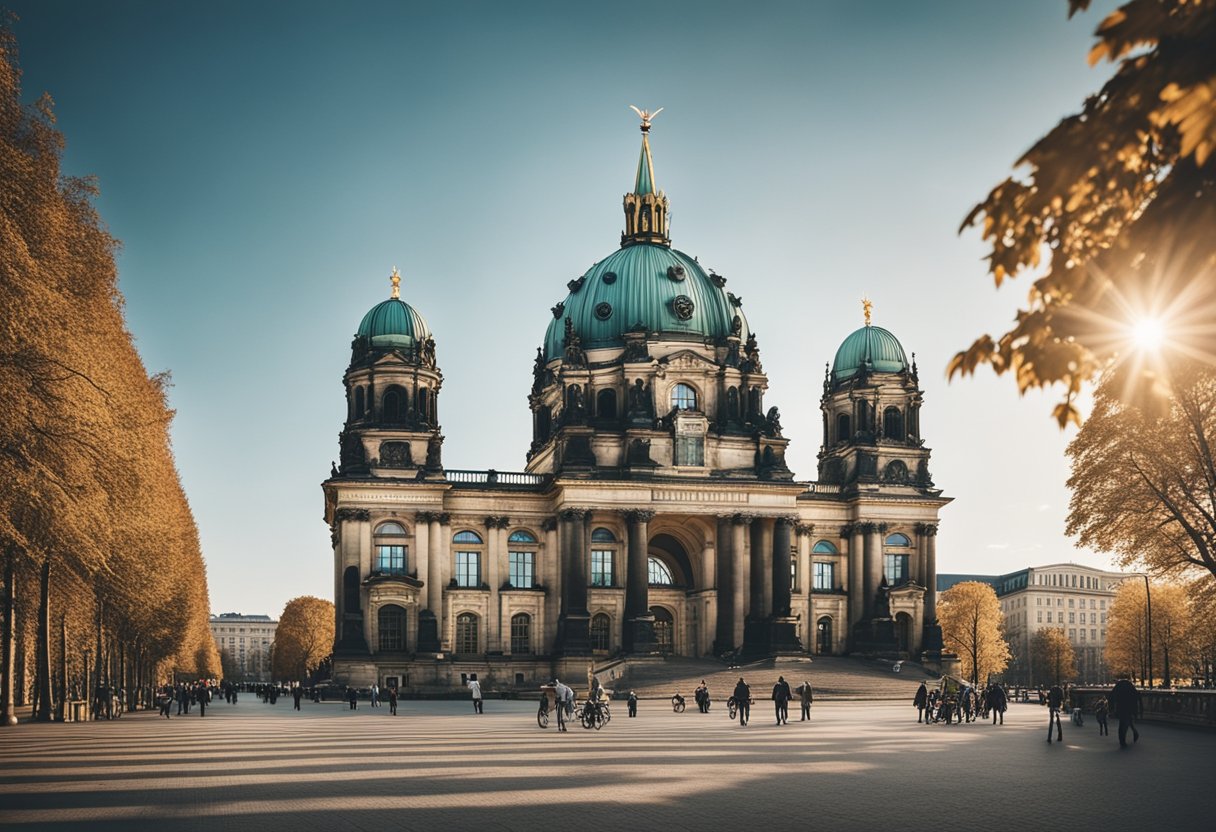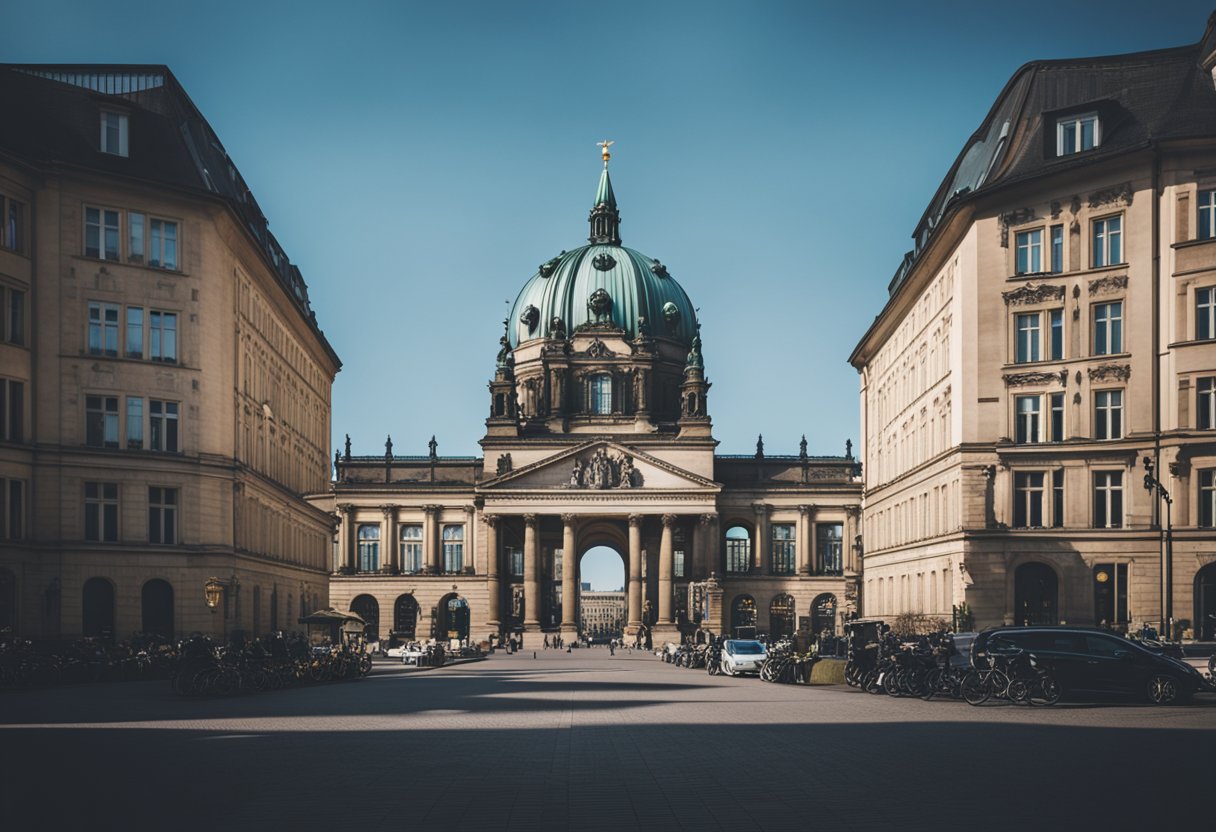The Rotes Rathaus stands as a landmark of governance in the heart of Berlin, the capital city of Germany. It is not just an administrative building but also a historical symbol that embodies the city’s rich past and progressive present.
The name translates to “Red City Hall” in English, attributed to its distinctive red brick facade rather than any political connotation. Housing the office of the Governing Mayor and the Senate of Berlin, the Rotes Rathaus is pivotal to the political life of the city.
Located on Rathausstraße, near the famous Alexanderplatz, the Rotes Rathaus is easily recognized by its remarkable architecture that draws visitor attention. Its foundation goes back to the 19th century, imparting a sense of the city’s expansive timeline.
As Berlin city hall Germany, the structure is not only a center for municipal affairs but also serves as a point of interest for those looking to understand Berlin’s governmental history.
As the city’s government seat, the Rotes Rathaus has seen Berlin through various historical changes, representing stability and continuity. The building’s impressive facade and ornate design reflect the importance of the institution it houses.
For anyone interested in the workings of German politics or the rich history of Berlin, a visit to the Rotes Rathaus offers a unique perspective on this vibrant European capital.
Historical Significance- Berlin City Hall Germany
Berlin City Hall, known as the Rotes Rathaus, stands as a testament to the city’s turbulent and rich history. This building has witnessed the evolution of Berlin from its Prussian roots to its modern role as the capital of a reunified Germany.
Foundation and Growth
Constructed between 1861 and 1869, Berlin City Hall became a symbol of Berlin’s growth and the burgeoning power of the newly established German Empire. Its role expanded as Berlin evolved into an industrial and political hub in the country.
World War II and Its Aftermath
During World War II, the city hall was heavily damaged in the Allied bombing campaigns. Post-war reconstruction was necessary to restore its function as the city government battled with the extensive devastation that beset Berlin.
Berlin Wall and German Reunification
The erection of the Berlin Wall in 1961 sliced through the city, but Berlin City Hall remained a point of continuity. The wall’s fall in 1989 set the stage for German reunification, with the Rotes Rathaus playing host to significant political events during this historic period.
Political Structure
Berlin’s dynamic political structure is embodied by the Governing Mayor who leads the city alongside the Senate of Berlin, managing not only local but also international affairs.
Governing Mayor and Administration
The Governing Mayor of Berlin serves as both the mayor of the city and the state premier, heading the Berlin Senate Chancellery, the city’s pivotal administrative team. This dual role reflects the unique position of Berlin as a city-state within the German federal system.
Senate of Berlin
The Senate of Berlin consists of the Governing Mayor and ten senators, each responsible for different departments. They collectively represent the executive government, enacting legislation, and administering policies and public services to manage the state effectively.
International Relations
Berlin, being the capital city, plays a significant role in international relations. It acts as a host to foreign diplomats and partners with institutions of the federal government, other federal states, and several associations. The city actively engages in diplomacy and global discussions, reinforcing its position as a significant player on the international stage.
Architecture and Landmarks
Berlin’s cityscape is marked by its iconic structures that chronicle its rich history and architectural evolution. Stately buildings and significant landmarks stand as testaments to the city’s past and present.
Rotes Rathaus and Rathausstraße
The Rotes Rathaus, or Red City Hall, is a standout structure in Berlin’s Mitte district. Designed by Hermann Friedrich Waesemann between 1861 and 1869, the building is a prime example of the neo-Renaissance style, with its striking red-brick façade making it an architectural staple of the city. The building’s name, translating to ‘Red City Hall,’ is derived from the distinctive color of the bricks.
Berlin Cathedral and Museum Island
One cannot overlook the Berlin Cathedral, an exemplary piece of historic architecture, majestically located on Museum Island. This area is not only a UNESCO World Heritage site but also home to a stunning complex of five museums. The Cathedral, with its grand dome, serves as a harmonious backdrop to Museum Island’s artistic and cultural institutions.
Historic Squares and Streets
Moving on, Gendarmenmarkt is among Berlin’s most beautiful squares, embraced by the harmonious trio of the Konzerthaus, the French Cathedral, and the German Cathedral. Its classical style contributes greatly to the architectural allure of the city.
Monuments and Memorials
Berlin also houses poignant Monuments and Memorials, such as the deeply moving Memorial to the Murdered Jews of Europe. Located in the city’s heart, it is a powerful tribute to the victims of the Holocaust, featuring 2,711 concrete slabs arranged in a grid pattern. Additionally, the Kaiser Wilhelm Memorial Church is a historical emblem preserved in its war-damaged state, symbolizing peace and reconciliation.
Cultural Attractions
Berlin’s City Hall, commonly referred to as the Rotes Rathaus, is not just a pivotal point of political life but also a gateway to the rich cultural fabric of the city.
This section encapsulates the diverse cultural experiences available in close proximity, from the world-renowned museums and exhibitions to the vivacious theater scene, and the vibrant festivals and events that Berlin hosts throughout the year.
Museums and Exhibitions
The area surrounding Berlin City Hall brims with cultural institutions, including the highly-acclaimed Pergamon Museum, located on Museum Island.
As part of the Staatliche Museen zu Berlin, it showcases ancient artifacts, such as the Pergamon Altar, providing visitors with a tangible link to history. Exhibitions across the city showcase both classical and contemporary works, catering to a wide range of artistic preferences.
Theaters and Orchestras
Berlin is home to a thriving theater scene, where traditional performances and modern interpretative pieces can be found.
The Hackesche Höfe cinema in the central borough presents independent films and is an iconic landmark of the cultural hub of Friedrichshain. The city’s love for performing arts is further embodied by its many orchestras, which regularly perform at various venues, delivering exquisite auditory experiences for classical music enthusiasts.
Festivals and Events
Throughout the year, Berlin’s events calendar is punctuated with a variety of festivals celebrating everything from film to food to fashion.
Cultural festivities within the city offer citizens and visitors alike a chance to engage with Berlin’s diverse artistic community. Celebrations often take place in public squares and streets, turning the city into a lively exhibition of performance and creativity.
Geography and Urban Districts
Berlin’s geography profoundly reflects its history, specifically in its urban districts and the division between the former East and West Berlin. This mosaic of history is evident when exploring Mitte, the central district, neighborhoods with unique identities like Kreuzberg, and the abundant public parks that serve as green lungs for the city.
Mitte District and Neighborhoods
The Mitte district serves as the historical heart of Berlin. It’s not only home to the iconic Berlin City Hall, known as Rotes Rathaus, but also encompasses a variety of neighborhoods such as the bustling Alexanderplatz and the historically charged Museum Island. The district of Mitte integrates old and new, blending historic sites with contemporary culture.
East and West Berlin Division
Berlin’s division into East Berlin and West Berlin during the Cold War left a lasting spatial and cultural impact on the city. Although the city is united today, this former split is still noticeable in architectural styles, urban planning, and public spaces. Kreuzberg, traditionally part of Former West Berlin, epitomizes this blend as a vibrant cultural hotspot.
Public Parks and Green Spaces
Berlin is renowned for its dedication to maintaining public parks and green spaces. The vast Tiergarten, located in the former West, provides a sprawling natural haven for both residents and visitors.
Meanwhile, the East’s Treptower Park and Friedrichshain offer expansive areas for leisure and recreation, showcasing the city’s commitment to urban greenery across all districts.
Economic Aspects
Berlin City Hall, situated centrally in Berlin, stands as a beacon for the city’s economic vitality, which is driven by its tourism sector, bustling local businesses, and robust infrastructure that caters to both residents and companies.
Tourism and Attractions
Berlin City Hall itself is an attraction for visitors, exemplifying the city’s rich political and historical significance. The vicinity of the City Hall is a nexus for tourism with landmarks like Alexanderplatz and the Red Town Hall drawing numerous tourists.
The city’s attractions such as the Brandenburg Gate and the Berlin Wall’s remnants infuse the economy with substantial tourism revenue. Potsdamer Platz, a public square and traffic intersection, is another magnet for visitors offering entertainment, shopping, and dining experiences that contribute to the city’s economic stream.
Local Businesses and Markets
The area around Berlin City Hall bustles with a variety of local businesses. Flea markets, such as the one at Mauerpark, provide a spot for both locals and tourists seeking unique items and vintage goods.
Berlin hotels capitalize on their proximity to major attractions, with hospitality being a significant economic pillar. Additionally, food and snack vendors near tourist hotspots add to the local economy’s diversity by offering authentic German cuisine and international delicacies.
Infrastructure and Residence
Berlin’s infrastructure, including transportation systems and residential buildings, is finely tuned to support both economic growth and the quality of urban living. Efficient public transport systems facilitate easy access to markets and jobs for Berlin’s residents, while also making attractions easily accessible for tourists.
Areas such as Potsdamer Platz have seen considerable development in both commercial and residential spaces, revealing a favorable economic trend towards property development and real estate investments within the region.
The continuous development of living spaces and commercial properties suggests a resilient and progressive economic milieu in Berlin.
Social Dynamics
Berlin’s social fabric is characterized by its diverse population, vibrant cultural scene, and esteemed educational institutions. These elements together create a dynamic community within the city, reflecting its progressive and inclusive ethos.
Population and Immigration
Berlin is a melting pot of cultures with a significant population of immigrants from around the world. This multicultural environment is lauded for fostering diversity and enriching Berlin’s cultural landscape. The city’s demographic profile continues to evolve, as it remains a prominent destination for people seeking new opportunities.
Cultural Events and Daily Life
The city is internationally recognized for its cultural events, attracting both local and global artists. Daily life in Berlin is interwoven with cultural experiences, ranging from music festivals to art exhibitions.
For instance, the bustling scene at Alexanderplatz, in the vicinity of Rotes Rathaus, underscores the city’s status as a hub for creativity and community gatherings.
Educational Institutions
Berlin boasts a robust network of educational institutions, with numerous schools, libraries, and universities. These institutions are cornerstones of the city, contributing to its reputation as a city of intellect and innovation.
The Free University of Berlin and Humboldt University are prime examples, being central to fostering academic advancements and societal contributions.
Environmental Policies
Berlin City Hall, the Rotes Rathaus, takes a committed stance on environmental stewardship, integrating environmental justice and sustainability into its urban framework. The municipalities of Berlin prioritize the enhancement of green spaces and the advancement of sustainability initiatives.
The city administration updated its Environmental Justice Atlas in July 2022, a tool used to ensure equal access to green spaces and to monitor environmental equity across its districts.
Berlin is dedicated to providing a healthy living environment for all its residents and utilizes interdepartmental collaboration for this purpose. More details on this can be found on Berlin’s official website for environment and sustainability.
Furthermore, Berlin’s legislature aims for the city to be climate-neutral by 2045. They passed the Berlin Energy and Climate Protection Programme 2030 (BEK 2030) which includes strategies and measures for mitigating climate change and adapting to its consequences. An ambitious interim goal is to cut carbon dioxide emissions by 70 percent by 2030 compared to 1990 levels.
| Year | CO2 Reduction Goal |
|---|---|
| 2030 | 70% |
| 2040 | 90% |
| 2045 | 95%+ |
Moreover, Berlin is a city that values its green spaces and works towards creating an urban area that balances development with nature preservation. Efforts to bolster the city’s green infrastructure include maintaining and expanding parks, gardens and aligning with the Sustainable Development Goals. This initiative aims to harmonize the city’s growth with environmental sustainability practices.
These environmental policies reflect Berlin’s robust commitment to not only improving the quality of life for its citizens but also its responsibility towards global ecological efforts.
Recreation and Leisure
Berlin City Hall, situated close to various iconic attractions, offers visitors a plethora of opportunities to explore recreation and leisure activities in the city’s vibrant heart. From exclusive shopping experiences to expansive green spaces, the area around Berlin City Hall serves as a gateway to some of the city’s foremost leisure pursuits.
Shopping and Culinary Experience
KaDeWe
One of Europe’s largest and most renowned department stores, KaDeWe (Kaufhaus des Westens), is a must-visit for shopaholics and food enthusiasts alike. The store prides itself on a luxurious shopping experience and an exquisite food hall that boasts a vast array of gourmet delicacies from around the world.
- Location: Tauentzienstraße 21-24, 10789 Berlin
- Highlights:
- Over 60,000 square metres of retail space
- The gourmet food hall found on the sixth floor
Hackescher Markt
For a more bohemian and unique shopping encounter, Hackescher Markt presents a lively atmosphere filled with boutiques, art galleries, and cafes. The area is well-known for its eccentric fashion and handcrafted jewelry, making it an ideal spot for finding one-of-a-kind items and enjoying Berlin’s creative flair.
- Location: Hackescher Markt, 10178 Berlin
- Break Time: Cafes and restaurants offering a respite for tired shoppers
Parks and Outdoor Activities
Parks
Berlin boasts an abundance of parks where locals and visitors can escape the bustle of city life. The vast Tempelhof Airport, now Tempelhofer Feld, is a unique open space offering a rich tapestry of outdoor activities. People flock here for picnics, kite-surfing, and cycling along the airport’s former runways.
- Activities:
- Leisurely walks, sports, and barbecues
- Community gardens and historical tours
Break Areas
In between shopping and exploring, visitors can take a break in the numerous small parks scattered around the city hall area. These pockets of tranquility offer a moment’s pause to reflect and enjoy the urban landscape.
- Tips:
- Seek out quieter spots for moments of relaxation
- Benches and shaded areas provide comfortable resting points
Transportation Network
Berlin City Hall, known as the Rotes Rathaus, is conveniently situated in the heart of Berlin’s extensive transportation network. This network caters to a diverse range of mobility needs, from public transportation to individual cycling paths.
Public Transportation
Berlin boasts an integrated public transportation system that effortlessly connects Berlin City Hall with the rest of the city. Comprising the S-Bahn (city trains), U-Bahn (subway), buses, and trams, the transport system is efficient and visitor-friendly.
Visitors can reach the City Hall using several bus lines or through the Alexanderplatz hub, where multiple train and tram connections converge. According to Berlin.de, a comprehensive ticketing system allows access to all modes of transport, simplifying navigation for users.
Roads and Cycling Paths
For those who prefer travelling by road, Berlin City Hall is accessible through well-maintained highways and streets. The city’s commitment to sustainable transport is evident in its expansive network of cycling paths.
Cycling is not only a popular mode of transport for residents but visitors as well, with designated lanes and bike-friendly services ensuring safety and convenience. The thoughtful integration of transport modes allows for seamless transitions between cycling and public transport options.
Public Services
Berlin City Hall, known as the Rotes Rathaus, is the central location for the administration of the city’s public services, including healthcare and emergency services. This ensures the well-being and safety of its residents and visitors.
Healthcare
Hospitals in Berlin are overseen by the city’s health administration to ensure that they provide quality medical care. The Charité – Universitätsmedizin Berlin is one of Europe’s largest university hospitals, affiliated with both Humboldt University and Free University Berlin, and it represents the forefront of medical innovation and healthcare services in the city.
Security and Emergency Services
The Berlin Police Department (Polizei Berlin) is responsible for maintaining public order and safety in the city. With its headquarters in Tempelhof-Schöneberg, it handles everything from traffic control to major crime investigations.
The Berlin Fire Brigade (Berliner Feuerwehr), on the other hand, provides rapid and professional fire-fighting and rescue services, making it a critical component in the city’s emergency response infrastructure. Both services are essential in supporting the city’s commitment to security and public welfare.
Frequently Asked Questions
The Rotes Rathaus is a central landmark in Berlin with a wealth of history and activities for visitors. Below are some specific queries that tourists frequently have when planning a visit to Berlin’s city hall.
How can you visit the interior of Berlin’s Rotes Rathaus?
Visitors can explore the interior of Berlin’s Rotes Rathaus Monday to Friday from 9 a.m. to 6 p.m. It’s important to verify in advance as it may be closed for official business or security reasons. Group tours can also be organized by contacting the senate office.
What are some can’t-miss activities near Berlin’s city hall?
In the vicinity of Berlin’s city hall, prominent landmarks like the TV tower, Brandenburg Gate, and Checkpoint Charlie are can’t-miss attractions.
What historical events impacted Berlin’s city hall during WW2?
Berlin’s Rotes Rathaus witnessed significant damage from air raids during WW2. It was later restored to preserve its historical Neo-Renaissance design.
How do you register at Berlin’s city hall?
For residents who need to register their address in Berlin, a process known as Anmeldung, Nomaden Berlin provides a comprehensive guide detailing exactly how, when, and where to carry this out.
What dining options are available within or near Berlin’s city hall?
Several dining establishments are available near Berlin’s city hall, offering everything from traditional German cuisine to international dishes.
When is the Christmas market at Berlin City Hall typically held?
The Christmas market at Berlin City Hall, known for its festive atmosphere, is typically held during the Advent season, starting from late November until Christmas.




